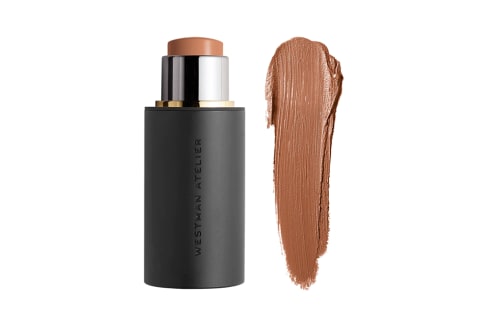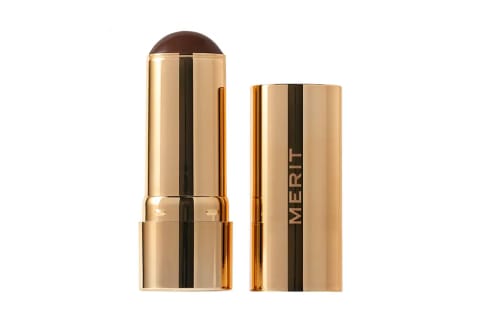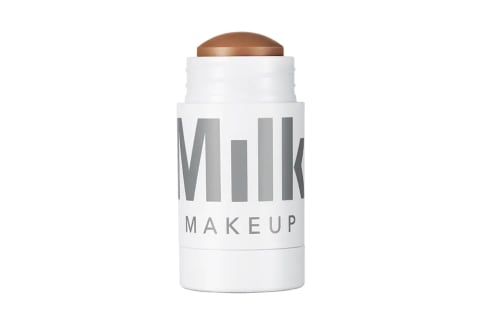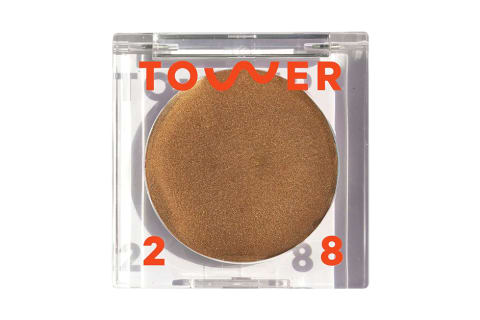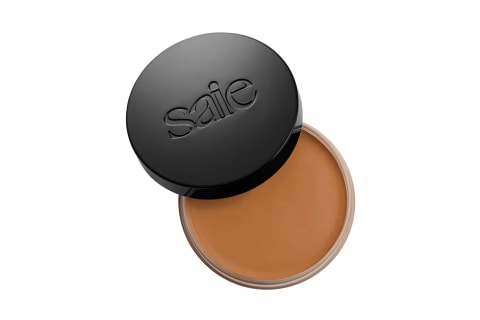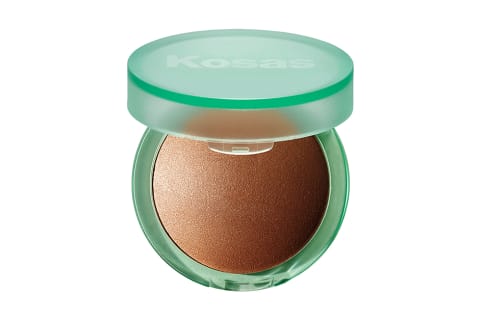Advertisement
Bronzer vs. Contour: What's The Difference + How To Use Them

If you want to use makeup to enhance your natural look, then you'll want to play up your favorite features. If you love your cheekbones, play around with highlighter to make them pop. If you love your eye color, try out a complementary eye shadow. And if you love your face shape but want a bit more snatch, then contour is for you.
However, using contour can be confusing, especially when it comes to picking the right product. What's more, it's very similar to another makeup staple you probably already own: bronzer. To follow, the difference between bronzer and contour, how to use them, and what to look for in your next purchase. Let's dive in.
Bronzer vs. contour: the difference?
On the surface, they may look very similar, but there are actually quite a few things that make them unique.
Use case
"The main difference between bronzer and contour is that bronzer brings warmth to the face whereas contour creates dimension," celebrity makeup artist Jamie Greenberg tells mbg. So if you want a sun-kissed glow, bronzer is a must. If you want to snatch your cheekbones, then contour products are the way to go.
Tone
But what makes them different in the first place? In part, the tone of bronzer and contour products tends to be different. "Your contour should be more cool toned, and your bronzer should be more warm toned," Greenberg says.
Your skin's natural undertones will of course affect just how warm and cool these are. For example, if you have naturally cool undertones, you may need just a slightly warmed-up bronzer—anything too warm may look orange on the skin. Or if you naturally have warm undertones, you'll need a contour that has some as well or it may look too flat.
Color shade
The depth of the color also plays a role. "I believe contour should be a deeper color than your true skin tone to create depth and dimension, while bronzer should be a warmer tone," New York–based makeup artist Alexandria Gilleo explains.
Finish
Some bronzers may have a hint of shimmer in them to reflect a natural glow, while contour tends to be matte. You can find matte bronzer as well (a few pics below), and only use highlighter on the high points of your face for a more precise glow.
Layering method
In a lineup, you'll want to use foundation and concealer beforehand, then put on your contour before your bronzer. After these steps, you'll want to go in with blush, highlighter, etc.
Overall
Think of bronzer as a product that will mimic your natural tan, while contour mimics a shadow on the face. You can technically use bronzer as contour, but it may not result in the same chiseled look, Greenberg says. And finally—you don't need both to create a fabulous makeup look; it's all about what you're going for. You should see these products as tools to enhance your vision, not change the way you look.
Summary: What makes a bronzer.
- Tone: Warmer
- Color shade: Mimics what your skin tone looks like with a natural tan
- Finish: Can be sparkly, shimmer, satin, dewy, or matte
- Layering method: After contour
Summary: What makes contour.
- Tone: Cooler
- Color shade: A few shades darker than your skin tone—meant to look like a shadow
- Finish: Matte
- Layering method: Before bronzer—can be before or after foundation depending on your application technique
What to look for.
When shopping for bronzer and contour products, you'll want to first establish whether you want powder or cream and then nail down a shade that complements your skin. Here's a quick overview:
Powder vs. cream formulas:
Bronzer and contour can come in many different forms—from powder pallets to cream sticks and beyond. Which one you should choose, Greenberg says, depends on how dry or oily your skin type is.
"If you have more dry skin, I would recommend using a cream bronzer," she notes.
If your skin is on the oily side, then a powder formula might be better—especially for long wear.
If your skin tends to run right down the middle, Gilleo recommends a combination. "I personally love cream to contour and powder to bronze," she explains. And if you're not sure what your skin type is, this quiz will help you out.
How to pick a color:
"Bronzer can be cool, neutral, or warm," Gilleo says. So, if you've tried bronzer that just doesn't mesh well with your skin, it may be due to a mismatch between the undertones of your skin and the undertones of the product. Try to keep cool with cool, warm with warm, and if you have neutral undertones (lucky you!), then you can play around with both. Not sure what your undertones are? Here's another quiz to make it easy.
If you're torn, opt for Greenberg's advice from above—select a cool-toned contour and a warmer bronzer to get the best of both worlds. Below, a few A+ clean formulas for each—and to follow, step-by-step instructions on how to use your products.
How to apply each.
Applying contour.
Applying contour tends to be a bit more confusing, so here's the overview. "For snatched cheekbones, start at your hairline near your ear, and create a line in the hollows of your cheeks, ending halfway between your hairline and your mouth," Greenberg says.
If you're using a cream product, then a blending brush or sponge will do. For powder, stick with a contour brush designed for powder products to blend. "Always blend upward to really get that sculpted look," Greenberg notes.
If you want your chin to look a bit more defined, "You should focus on the jawline and make sure to contour just below the chin," Greenberg says. Be sure to blend down into the neck to avoid harsh lines.
And finally—if you want to elongate your face, then apply contour on the top sides of your forehead near your hairline, but avoid the top center. If you want to shorten the face, then swipe the contour on the top of your forehead in an upside-down "U" shape.
This was a very, very brief overview—here's a full guide if you want to dive deeper into this step.
The best contour products.
Applying bronzer.
Luckily, applying bronzer is much less complex. Bronzer is simply used to add warmth to the face—that natural sun-kissed glow that oftentimes gets covered up with foundation and concealer.
You can apply bronzer to anywhere the sun would naturally hit your face—think top of the forehead, the cheekbones, the tip of the chin, the bridge of the nose, etc. You may be thinking these spots are similar spots as the contour application placements above; however, contour is more about mimicking shadows—this is about reflecting light and warmth.
As professional makeup artist Asta Jurake shows in this Instagram tutorial, you can be a bit more generous with your bronzer. While contour should be blended carefully and kept in certain areas, bronzer can be more widespread.
You can technically apply bronzer and contour at the same time and then blend them in (similar to the method of underpainting). However, it may be easier to gauge how much bronzer you truly need after blending in the contour.
And if this is all too much and you're simply looking for a vacation-esque glow, then you can add a pump of liquid bronzer to your foundation for an easy boost—the Saie Beauty Glowy Super Gel in Sunglow is perfect for this step.
Best bronzer products.
Do you need both?
Here's the thing—for a full-glam look (especially if you'll be in front of the camera), most makeup artists will suggest using both bronzer and contour for the best results. However—you don't technically need every step, especially every day.
If a summery glow is more your vibe, then bronzer will be your best friend. You can toss in contour when you're looking for more facial definition or feel like going the extra mile for whatever reason.
On the flip side, if you're looking to keep your cheekbones or chin snatched on the daily, then contour may take up a spot in your makeup essentials lineup.
While these rules and guidelines are helpful for basic makeup how-to's, it's important to remember that you know your face and skin better than anyone else, so pick products that make you feel good—and use them however you see fit.
FAQ
What color bronzer should I use for contour?
If you're using bronzer as contour, use a cool-toned product. Look for ashy colors with gray hues rather than warm tones with orange hues.
What is the difference between bronzer and contour?
Bronzer tends to have warmer tones, while contour is a cool-toned product. Contour should be a deeper color to create shadows on the face, while bronzer should replicate your skin's natural tan.
Should contour be darker than bronzer?
"I believe contour should be a deeper color than your true skin tone to create depth and dimension, while bronzer should be a warmer tone," New York City–based makeup artist Alexandria Gilleo explains.
Where do I put contour vs. bronzer?
"For snatched cheekbones, start at your hairline near your ear, and create a line in the hollows of your cheeks, ending halfway between your hairline and your mouth," Greenberg says. To contour your chin, run the product along the jawline and blend down the neck. To shorten the face, apply contour in an upside down "U" shape on the forehead. Bronzer should be applied anywhere the sun naturally hits the face.
Can you apply bronzer all over your face?
If you want a tan or sun-kissed glow all over your face, opt for a liquid bronzing gel and mix it into your foundation or primer rather than putting cream or powder bronzer all over your face.
Is cream or powder bronzer better?
Which one you should choose, Greenberg says, depends on your skin type. "If you have more dry skin, I would recommend using a cream bronzer," she notes. If your skin is on the oily side, then a powder formula might be better—especially for long wear. Use a cream contour and a powder bronzer if your skin is right down the middle.
The takeaway.
If you want to make your jawline pop, contour is one tool you'll want to keep on deck. If you love a sun-kissed glow year-round, then bronzer is the best option—when used together, you'll be enhancing your look even more. Now you know how to pick the best product and how to apply it. The next step? A blush color that will complement your natural flush—here's how to tell.
